Pitso Mosimane has enjoyed a successful start to life at Al Ahly since taking the reins at the Egyptian club on 2nd October.
He joined the Red Devils in time to help them see out the 2019/20 season in style, as they won the Egyptian Premier League, the Egyptian Cup, and the CAF Champions League.
More recently, Pitso Mosimane’s tactics guided his team to the bronze medal in the 2020 FIFA Club World Cup—their joint-best-ever performance in that competition, a feat they achieved just once before, in 2006.
Al Ahly have lost just two of their first 26 games under the former Mamelodi Sundowns manager, who won five Premier Soccer League titles and one CAF Champions League during his eight-year tenure with the South African side, which ended as he embarked on his new challenge with Al Ahly, and in this tactical analysis, we’re going to take a look at the tactics Mosimane has deployed with his new side, which have helped them to perform so well under the 56-year-old during the early stages of his tenure in charge.
This tactical analysis will explore Mosimane’s tactical philosophy and analyse some of his Al Ahly side’s key strengths and weaknesses, on and off the ball.
Al Ahly’s shape and positional roles under Mosimane
We’ll kick off this tactical analysis by looking at how Mosimane’s Al Ahly side has typically lined up, both in terms of the personnel that usually take to the field and their typical formation.
Mosimane has mainly utilised a 4-2-3-1 shape with his Al Ahly side.
Under this manager, the Red Devils have also played in a 4-3-3 formation, but only on a handful of occasions.
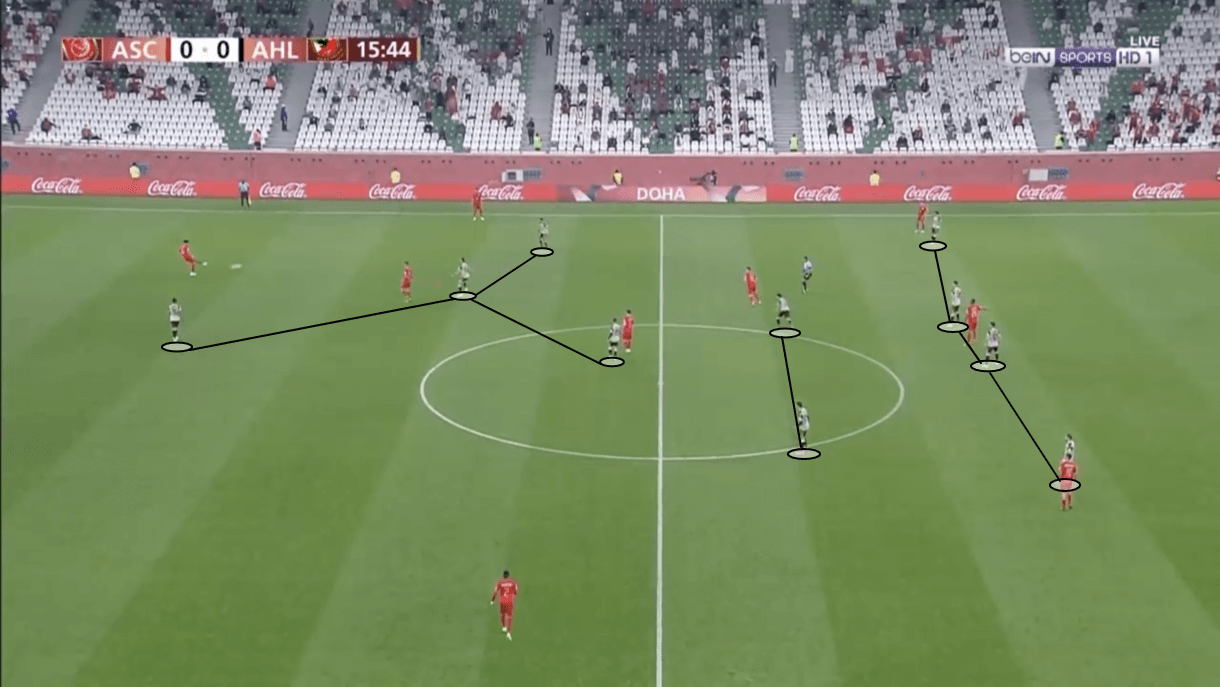
In Figure 1, Al Ahly can be seen lined up in their 4-2-3-1 shape out of possession while their opponents are playing out from the back.
We can see that they’re utilising a fairly high block here, and their 4-2-3-1 is very compact, both vertically and horizontally, with Red Devils players sticking very close to ball-near opponents.
This is typical of the way Mosimane sets up his team.
He likes to defend high up the pitch and deny the opposition much space to play out from the back and play short passes in general, as we’ll discuss at greater length later on in this tactical analysis.
In possession, Al Ahly’s two full-backs tend to get relatively high from the very beginning of an attack.
As a result, they’re rarely seen in line with the centre-backs.
During the build-up, they usually form a four-man line with the two holding midfielders.
The centre-backs are usually tasked with receiving the ball from the goalkeeper and kickstarting an offensive move via their passing quality.
As a result, their ball-playing ability, speed, and aerial ability are quite important in their defensive roles.
In the latter stages of an attack, the full-backs provide width inside the final third, helping the Red Devils create a five—or six-man offensive line, depending on the positioning of the attacking midfielder at that particular moment.
The holding midfielders and centre-backs generally stay back to provide a deeper passing option and cover in the event of a counterattack, while the wide attackers pick up a narrower position and play as inside forwards.
It’s important to note that Al Ahly’s four-man forward line, including the ‘number 10’, is very fluid, both in terms of which exact player performs which role at a given time and in terms of the positions in which the players can be found.
The front four swap positions fairly regularly in-game, and they’re also constantly on the move.
At times, the ‘10’ will make a run in behind, while other attackers drop off to provide a short passing option and vice versa.
This can make them unpredictable and challenging for the opponent to defend against.
As for personnel, Mosimane has been more experimental than he has with formations.
While he has favoured a 4-2-3-1 shape from the word go at The Club of The Century, plenty of different players have taken to the field, but it seems like, at this stage, his favourite XI would consist of:
Goalkeeper – Mohamed El Shenawy, right-back – Mohamed Hany, left-back – Ali Maâloul, right centre-back – Badr Benoun, left centre-back – Ayman Ashraf, a holding midfield pairing of – Hamdy Fathy and Aliou Dieng, right-winger – Hussein El Shahat, left-winger – Mahmoud Kahraba, attacking midfielder – Afsha and centre-forward – Walter Bwalya.
Other Al Ahly players who have featured at least semi-regularly under Mosimane include centre-back Yasser Ibrahim, right-back Beckham, left-back Mahmoud Wahid, central midfielders Akram Tawfik and Amr El Solia, and attackers Walid Soliman, Junior Ajayi, Taher Mohamed, and Mohamed Sherif.
Al Ahly’s build-up play under Pitso Mosimane Tactics
Now, we’ll take a more in-depth look at the early-mid stages of a typical Al Ahly attack under Mosimane, analysing how they go about their build-up play.
Firstly, it’s important to note that Al Ahly has been extremely focused on playing many short passes under Mosimane.
A high volume of passes has been a cornerstone of their tactics under the 56-year-old, and they’ve relied on performing to an especially high level in this aspect of their game to progress through the thirds and into the penalty box, which they’ve managed to do with great regularity.
This indicates that the focus that’s been placed on this area of their game under Mosimane has been successful.
Al Ahly has retained the second-highest possession percentage (58.3%) of any team in the Egyptian Premier League so far this season, trailing only Pyramids FC in that area.
However, despite keeping a lower average possession percentage than Pyramids, they’ve played significantly more passes per 90 than them and any other team in Egypt’s first tier.
So far this term, Al Ahly has played 500.01 passes per 90 minutes in the league, which is significantly higher than the league average of 350.07.
It has an accuracy of 84.9%, which is also the highest in the league.
The reigning Egyptian Premier League champions also have the highest passing rate (passes per minute of possession) of any team in Egypt’s top tier (15.9), which may explain why they’ve made a lot more passes per 90 minutes than Pyramids despite retaining a lower average percentage of possession.
They focus on playing into the final third via their passes far more than they do via dribbles or any other means.
Despite being a possession-based side, they have made just 23.52 dribbles per 90 minutes in the league this season, the fifth-lowest of any Egyptian Premier League team.
This may highlight just how much emphasis Mosimane’s side places on the skill of passing, as their volume of passes vastly outweighs their volume of dribbles.
Despite that, Al Ahly has made more touches in the penalty area (24.24) than any other Egyptian Premier League side.
One contributing factor to this is that the dribbles they have made inside the final third have been successful at getting them into the box – which may be somewhat true, as their most frequent dribblers are their attackers – and, to a lesser extent, full-backs – and Al Ahly’s dribble success rate is 53.5% – the sixth-highest of any Egyptian Premier League team, indicating that their dribble success has been far greater than the volume of dribbles they’ve attempted.
Their success at playing into the penalty area is also down to the fact that their passing, which is the key attribute of this team, has been very successful at getting them through the thirds, past the opposition backline, and into the box.
This shows that Mosimane’s side doesn’t just play lots of passes; they are effective at getting into threatening positions via their passing moves.
The fact that Al-Ahly have also played the most progressive passes per 90 (89.59), by far, of any Egyptian Premier League side so far this season also suggests that they aren’t a side that just keeps possession and plays lots of passes for the sake of it, and while it’s true that not every pass they play will, in and of itself, get them closer to the goal, they are relatively very active in breaking lines and getting the ball forward via positive passing plays, constantly posing a threat to the opposition.
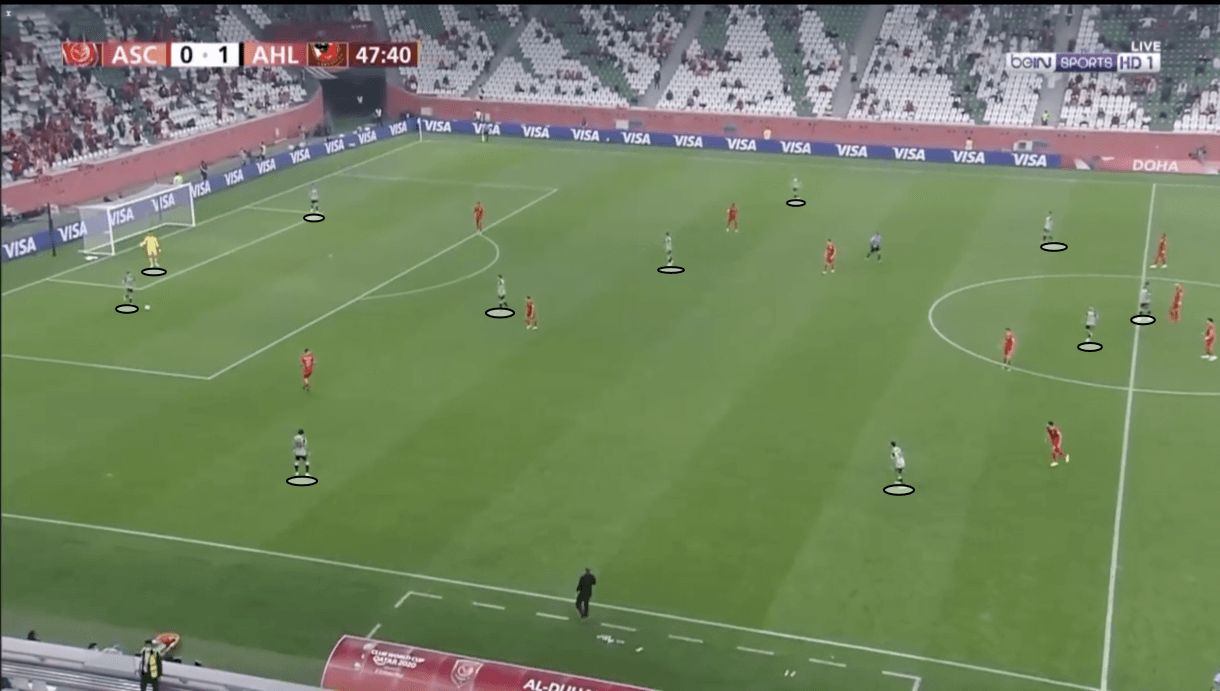
With that context of Mosimane’s Al Ahly in mind, we’ll now examine a typical passage of build-up play from this side.
Figure 2 shows us an example of a typical Al Ahly goal-kick.
The Red Devils are in a 2-4-3-1 formation here, with the centrebacks dropping deep on either side of the goalkeeper and the fullbacks pushing high alongside the holding midfielders.
This is a very normal scene at this stage of the attack on The Club of the Century under Mosimane.
A typical Al Ahly goal kick sees El Shenawy pass the ball to one of the two centre-backs, who then gets their head up and plays a forward pass.
They’ll usually find either an attacker dropping deep into the midfield to offer support via their pass or play the ball out wide to the full-back.
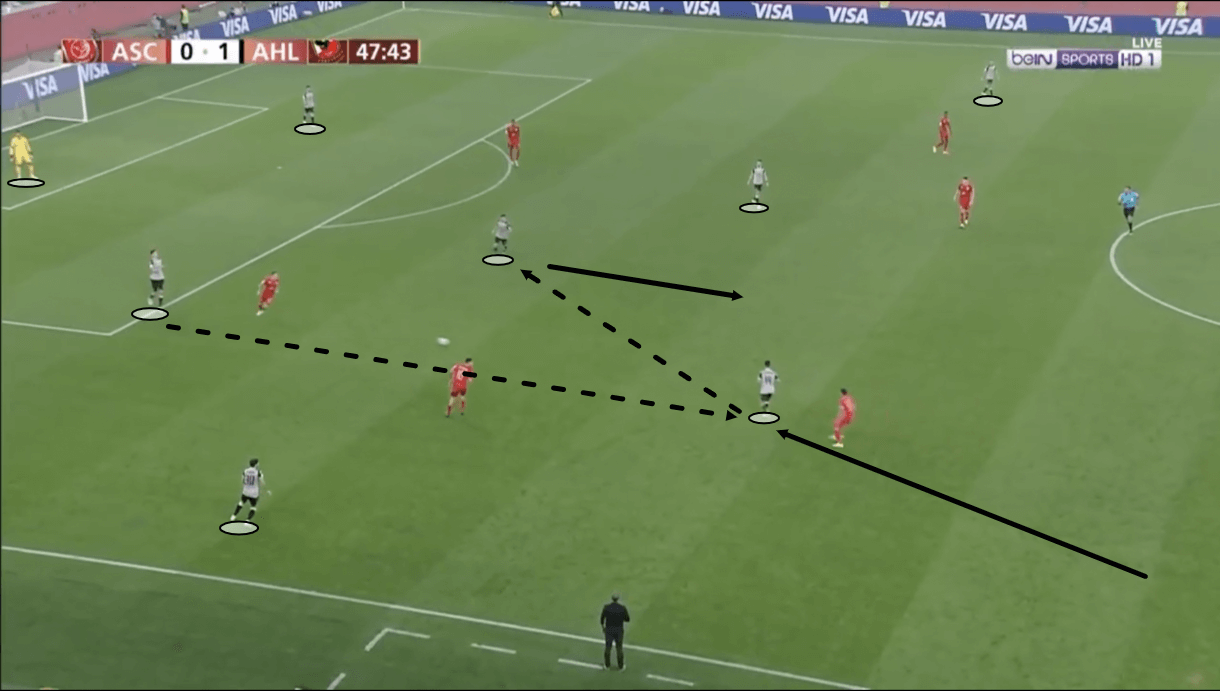
As this particular passage of play unfolds in Figure 3, the left winger drops deep into the midfield to collect the ball from the centre-back.
As we mentioned earlier in this tactical analysis, Al Ahly’s front four are very fluid in terms of their movement under Mosimane, and this is one common example of that fluidity.
The wide forwards often drop deep in the build-up to offer support to the centre-back and become an additional central midfielder, helping to create numerical superiority in the centre of the pitch when building an attack.
After this attacker receives the ball, he plays it off to the nearest holding midfielder, who can now receive it facing forward.
As a result, he doesn’t need to worry about being pressed from behind or taking time to turn, as he would if he had received the initial pass from the centre-back.
Instead, he can quickly take the ball forward and look to build into the middle third of the pitch and beyond, which is what he does here.
It’s common to see Mosimane’s Al Ahly side pull off this move in the build-up, as it’s important for this team to build through the holding midfielders.
A key part of these players’ roles is progressing in play, and Dieng, in particular, is a star in that regard.
He has played by far the most progressive passes per 90 (13.7) of any Al Ahly player in the league this season.
So, he is someone whose deep-playmaking quality Mosimane has looked to utilise extensively at The Club of The Century.
Fathi and the full-backs are also essential members of the team in terms of ball progression, indicating that this line of four ahead of the centre-backs are very important in this regard.
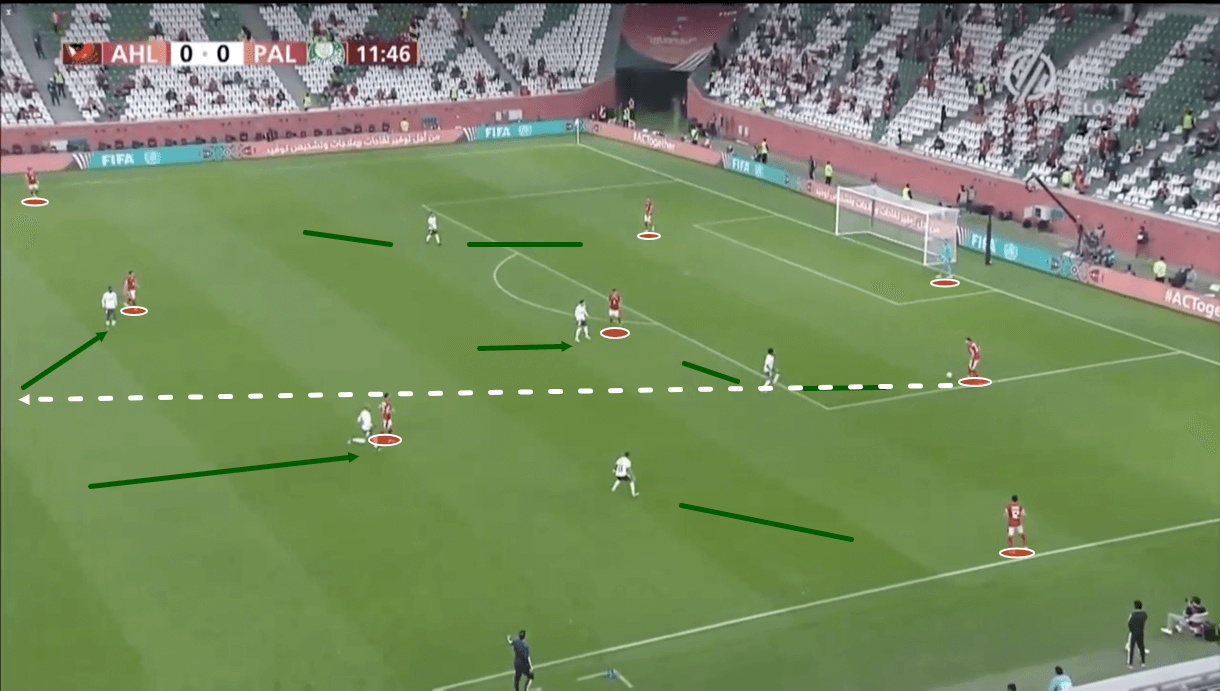
While their passing has been important and generally impressive under Mosimane, Al Ahly is not without fault in this area.
They have displayed some weaknesses, particularly during the build-up that opposing teams have exploited of late.
Figure 4 displays one of these weaknesses.
It shows another example of Al Ahly building out from a goal kick.
When the opposition presses Al Ahly’s backline high and marks/cuts off the passing lanes to the near passing options that they usually use in the build-up, they struggle at times, as was the case in this particular example.
Here, the left centre-back was pressed while all passing options in the midfield were marked tightly.
One opposition player was positioned intelligently on both the right centre-back and the left-back in case this player opted to play out through them, which led to the left centre-back steering clear of those potential passing options and playing the ball long instead.
This long ball didn’t meet another red shirt, however, as the opposition backline successfully regained possession.
So, this pressure was effective at forcing Al Ahly long, in turn causing a turnover of possession, and this isn’t the only occasion where this has occurred.
Al Ahly’s centre-backs do succumb to pressure at times and this is something that can be exploited.
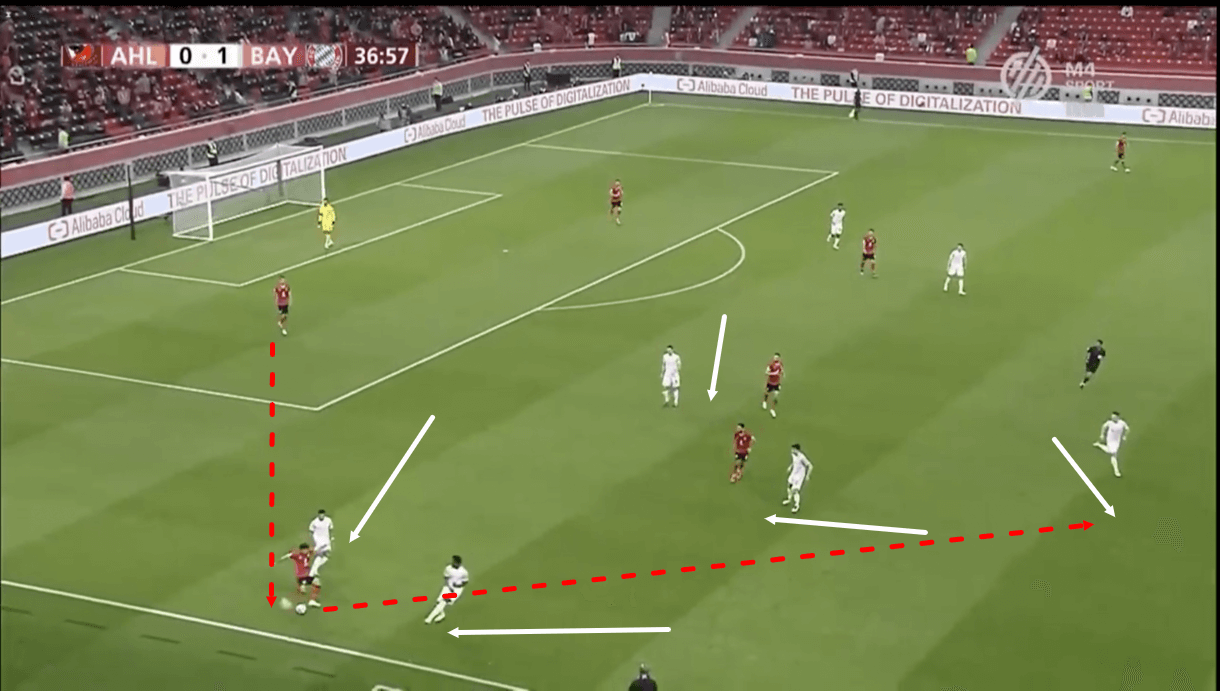
However, as
shown in Figure 5, while Al Ahly’s centre-backs can make errors under pressure, the full-backs tend to make even more, which reigning Bundesliga and UEFA Champions League champions Bayern Munich exploitedin their recent Club World Cup semi-final win over the Red Devils.
This image shows us that Bayern took a similar approach to pressing Hany at right back here as Palmeiras took to pressing the left centre-back in the previous passage of play.
They pressed high and marked/cut off passing lanes to the nearest passing options while closing down the man on the ball, forcing him to play a hasty pass, leading to a turnover.
Al Ahly’s full-backs tend to be targeted by the opposition even more than the centre-backs usually are.
Due to their natural close proximity to the sideline, they simply have even less passing range available to them. This essentially acts as an extra defender for the opposition, helping them to win the ball back.
These examples demonstrate that Al Ahly’s backline can falter under pressure when playing out from the back at times, with the full-backs proving particularly vulnerable.
Perhaps this is something opposition teams should continue looking to exploit.
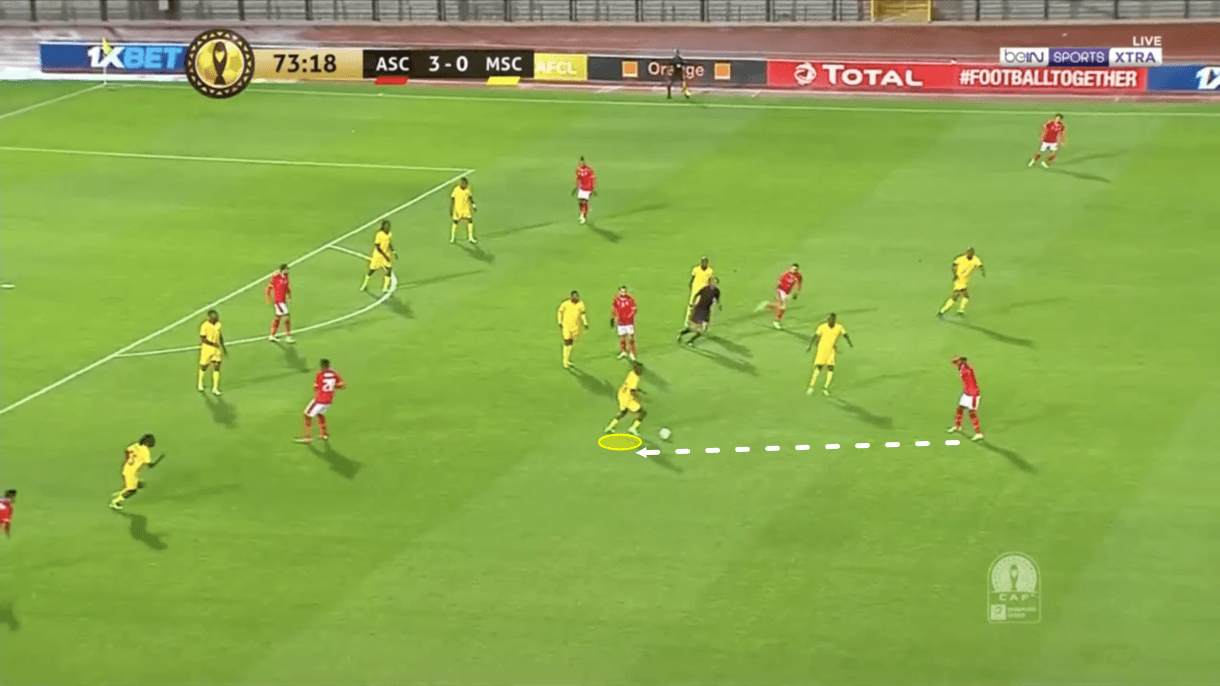
It’s not just against aggressive defences that Al Ahly’s weaknesses have come to light, however.
They have also had weaknesses exploited when playing against deeper defences, which was the case in figure 6.
Here, the opposition was defending deep, and Al Ahly had committed lots of bodies forward at the time.
However, as Mosimane’s side tried to play aggressively and pass into the final third, they failed to squeeze the ball through a compact opposition block and ended up giving the ball away.
This allowed the opposition to spring a counterattack while they had many men committed upfield.
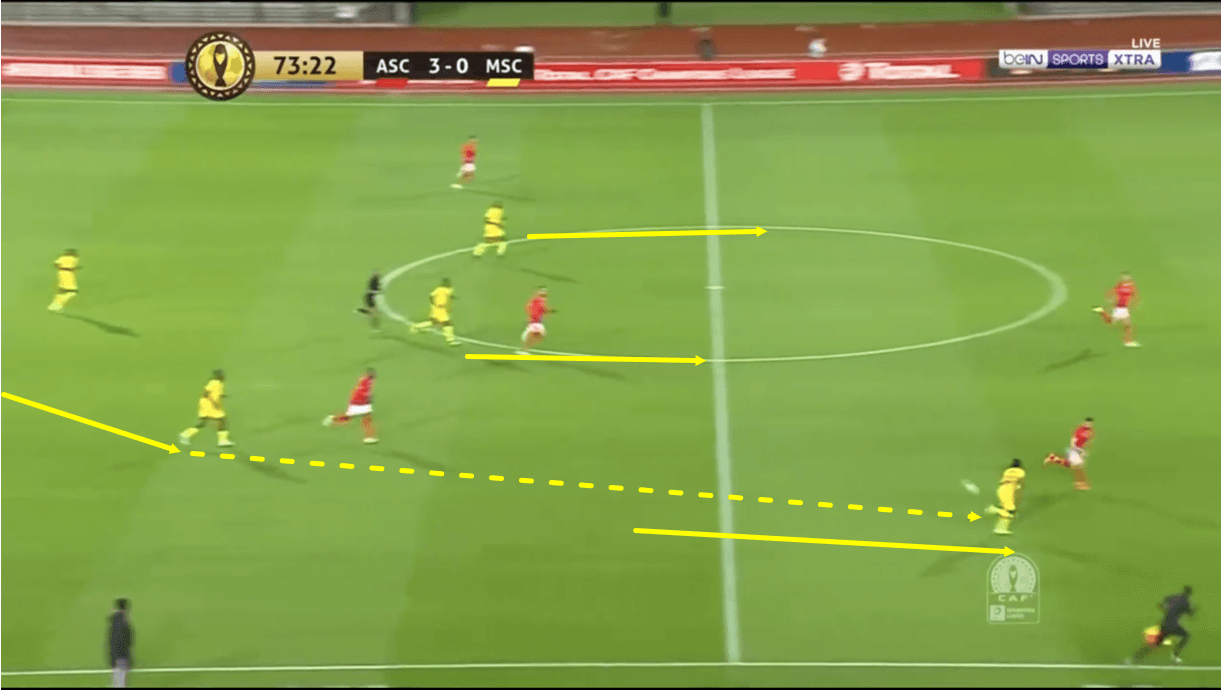
As the play moves on, and as Figure 7 shows, this player who stole possession from Al Ahly sends the ball forward, plays a through pass to a teammate, and makes a run down the right wing.
This stretched Al Ahly’s backline considerably, knowing how many men they had committed upfield.
It also created a dangerous situation with other opposition players attacking the opposite side of the pitch and running into free space.
This example highlights that Al Ahly leaves themselves somewhat open to being exploited on the counter if they misplace a pass high up the pitch.
While they’ve got strong passing accuracy, that can happen at times due to the sheer volume of passes that they play and the fact that they look to play a lot of progressive passes.
As a result, it can also be a wise tactic for opposing teams to defend deep, making it difficult for Al Ahly to play through the lines and bide their time waiting for an opportunity to strike on the counter.
Figures 4-7 show that Al Ahly can be exploited in several ways in the transition to defence, and these may be some ways that teams can harm them.
However, not many have managed to do so thus far in Mosimane’s reign, which speaks to Al Ahly’s ability to minimise the number of times that they let these errors occur and exploit these weaknesses.
Al Ahly in the final third under Pitso Mosimane Tactics
Now, we’ll move on to taking a closer look at Al Ahly’s tactics in the final third under Mosimane.
As mentioned, Al Ahly has been very successful at building into the final third and the penalty area under the ex-Mamelodi Sundowns boss.
Their entries into the final third and penalty area have not been without reward, either.
The Red Devils have scored the most goals per 90 minutes (1.94) of any team in Egypt’s top tier this term.
Al Ahly have also been very active in front of goal in terms of their shot volume.
They’ve taken more shots per 90 (14.63) than any other Egyptian Premier League side this season, while they’ve also got the fifth-highest xG per shot of any Egyptian Premier League team at present, indicating that they don’t just take a lot of shots, but they tend to take their shots from good positions, relative to the rest of the league.
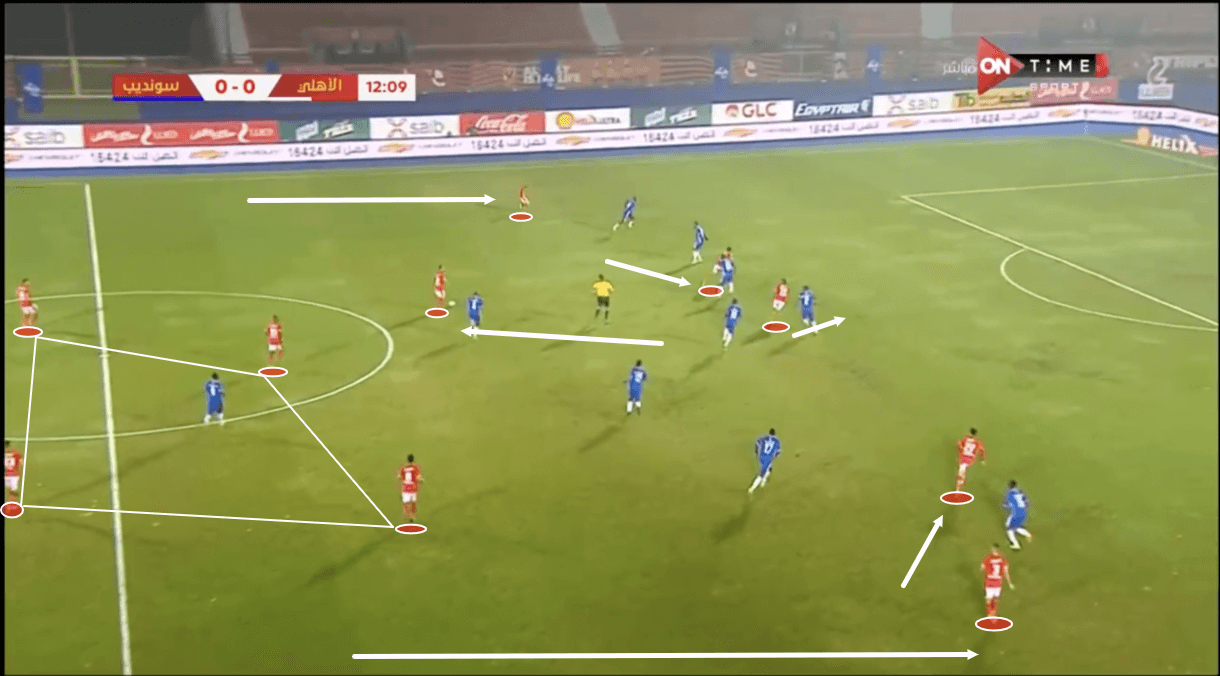
Figure 8 shows us Al Ahly’s usual shape in and around the final third, which plays an important role in helping them create so many high-quality goalscoring chances.
As previously mentioned, Mosimane deploys very offensive full-backs, who provide width for his side in the final third, while the wide forwards are more narrow, as this image depicts.
At the base of the formation, the holding midfielders and the centre-backs form a 2-2 shape.
At this stage, the ‘10’ is on the ball after dropping slightly off the forward line, occupying this space between the holding midfield duo and the now-five-man frontline.
It’s common to find the ‘10’ in these positions in a line of his own between the forwards and the holding midfielders, as his movement, in particular, in between the lines, is very important for helping the deeper playmakers to progress the play.
They often look to him and his movement between the lines to help them move from the middle third of the pitch to the final third, as was the case here, so he needs to be able to find space between the lines.
As the full-backs push high, they combine with the attackers to overload the opposition backline.
We can see that the right-back and right-winger have created a 2v1 overload versus the opposition left-back here.
This leads to the right-winger finding a lot of space via his diagonal run inside, which the ‘10’ finds thanks to his passing quality and impressive vision.
This passage of play provides just one example of how Mosimane’s set-up inside the final third has helped his side create many high-quality chances.
Al Ahly’s offensive play under Pitso Mosimane’s style of play involves a combination of positioning, movement, and technical passing quality.
Those three elements are key to their attack, and all of them are on display in this particular example.
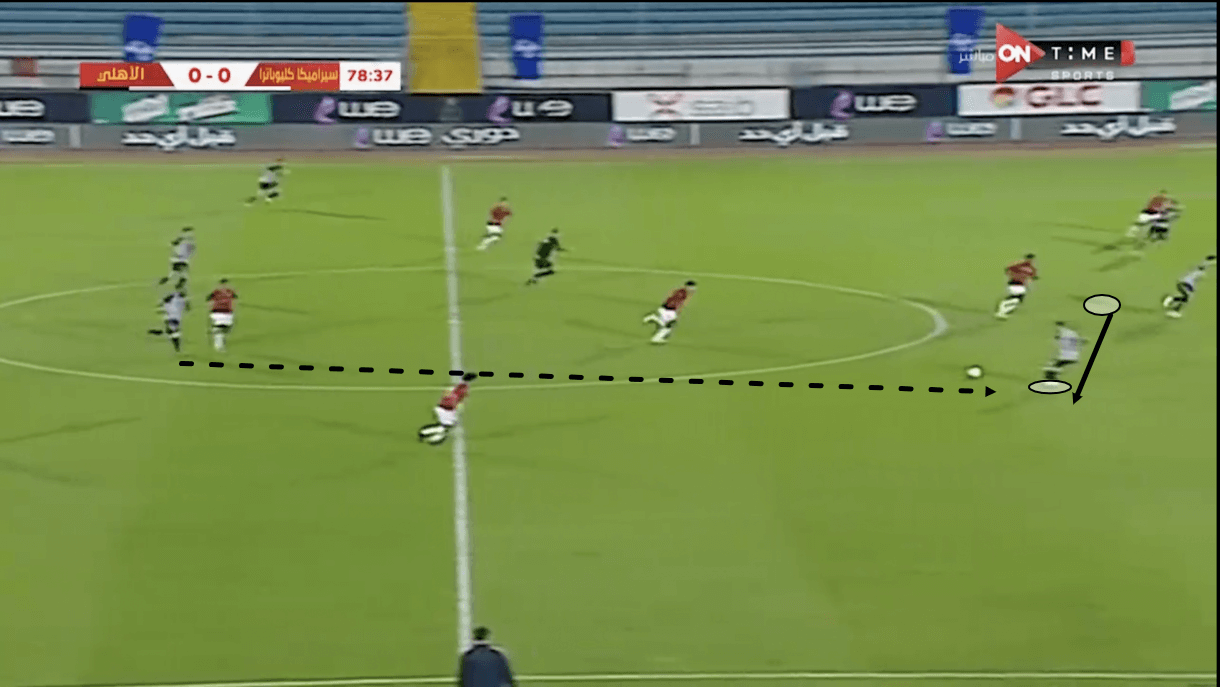
Figure 9 shows us another example of Al Ahly’s ‘10’ repositioning himself to find space in between the lines from where he can receive a pass from a deeper playmaker and become the link man between those players and the runners in behind.
This time, he can be seen on the right of the attack rather than the left as in the previous example.
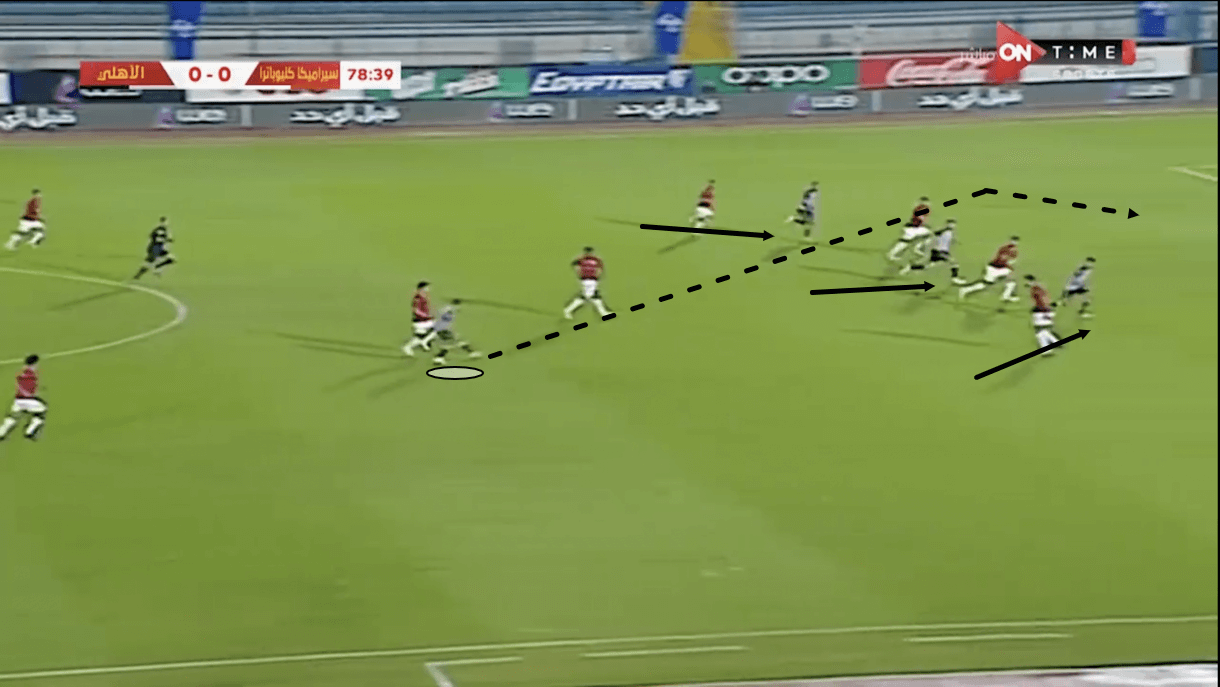
In Figure 10, as the play moves on, we can see that the remaining three members of Al Ahly’s offensive line are all making probing runs behind for the ‘10’ to pick out.
As he plays the through ball, these three attackers ultimately find themselves in a 3v2 situation versus the two opposition centre-backs after the full-backs don’t track the runs, which is very beneficial for them and results in an excellent goalscoring opportunity.
Through balls like this are another key, standard feature of Al Ahly’s game under Mosimane.
The ‘10’ and the wingers are the primary through-ball players in this Red Devils side, which has played by far the most through balls (13.19) of any Egyptian Premier League team this term.
Additionally, the volume at which they’ve played through balls has not harmed the overall quality of their through balls, as Mosimane’s side have also got the best through ball accuracy (40.3%) of any team in the Egyptian Premier League for the 2020/21 campaign.
Movements like the ’10s’ movement here and similar movements between the lines from the wingers are key to helping Al Ahly thrive in the through-ball area, thus playing a pivotal role in their overall attacking success.
The centre-backs take the ball from the goalkeeper and play it onto someone in the four-man line ahead of them, whose job it then is to progress the play a significant distance upfield, and the movement of the ‘10’ and wingers in between the lines is crucial in helping them to perform that role and complete those passes, while it’s also essential that they put themselves in an excellent position to receive the passes as they must then fulfil their role in building the attack, which is playing the killer ball in behind.
What we’ve analysed so far clearly shows the natural progression of Al Ahly’s play, and the elements of positioning, movement, and technical quality always play a starring role.
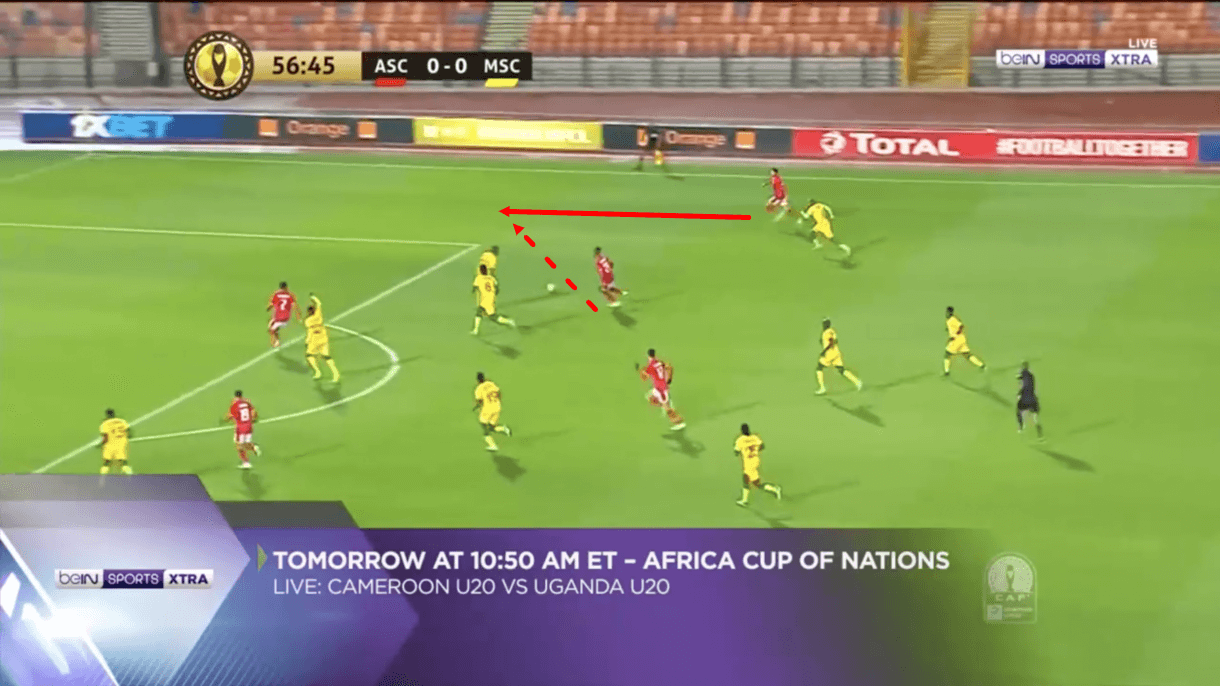
Figure 11 shows us an example of one of the wingers dropping slightly deeper to collect the ball.
With the ‘10’ finding it difficult to find space between the lines, one winger will also often drop deep to create an additional problem for the opposition to have to try and cope with.
As the right-winger collects the ball, he turns. Having pinned the opposition left-back in a narrow position, he finds the overlapping right-back running in behind out wide with a through ball of his own, putting the right-back in a dangerous position to create a chance for Al Ahly.
It’s important to note that Mosimane’s side doesn’t just make it into the penalty box via through balls but also via crosses.
They have played more crosses per 90 minutes (17.59) than any other Egyptian Premier League side this season, and similar to the through balls, this high cross volume has not harmed their crossing quality.
Al Ahly also impressively had the best cross accuracy (42.4%) of any team in Egypt’s top tier for the 2020/21 campaign.
While the wingers and the ‘10’ are the key men in this side concerning through balls, the full-backs are the key man in terms of creating chances via crosses.
Left-back Maâloul has played more crosses per 90 than any other Al Ahly player (5.93) with 41.38% accuracy, while right-back Hany comes second in the crosses per 90 list (4.39) with 47.83% crossing accuracy, so it’s clear that this is a vital part of their role in this team, which may not come as a massive surprise given that the full-backs are tasked with providing the width inside the final third.
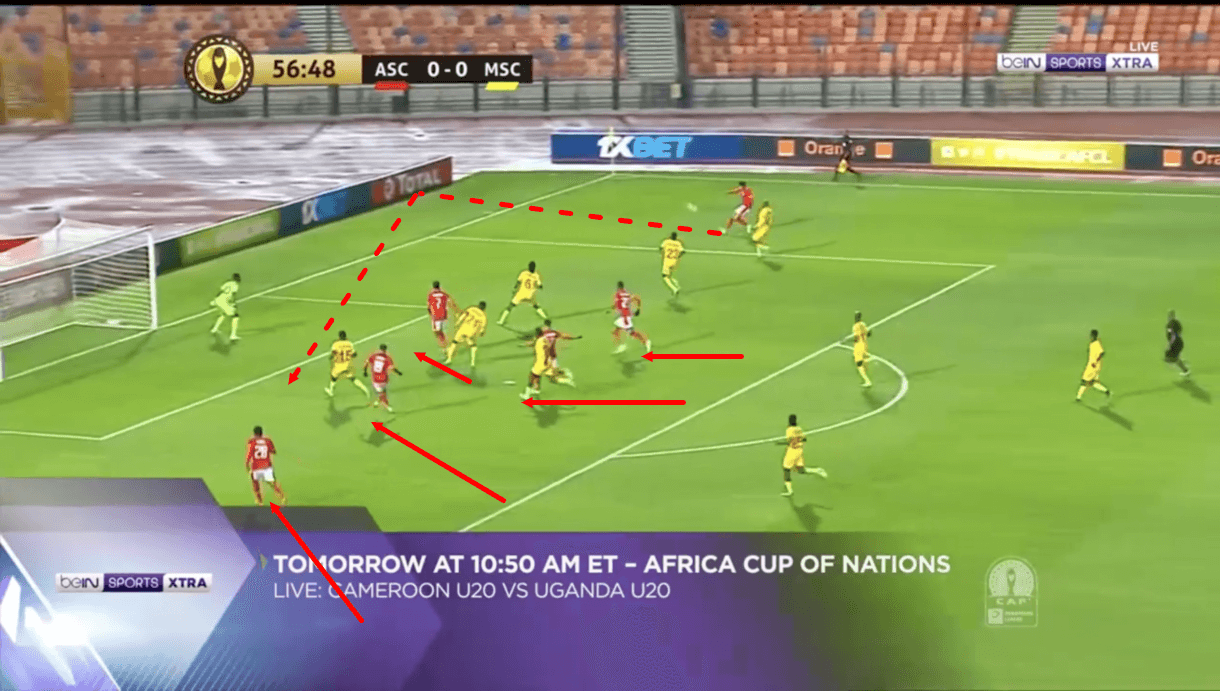
As this particular passage of play progresses in Figure 12, Hany plays a high cross into the penalty area, which has become swarmed with red shirts.
Al Ahly likes to get lots of bodies in the penalty area for crosses to try and make the most of this element of their game. It pays off on this particular occasion, as Afsha gets onto the end of the ball to score and put his side ahead, proving how deadly this aspect of the Red Devils’ game can be.
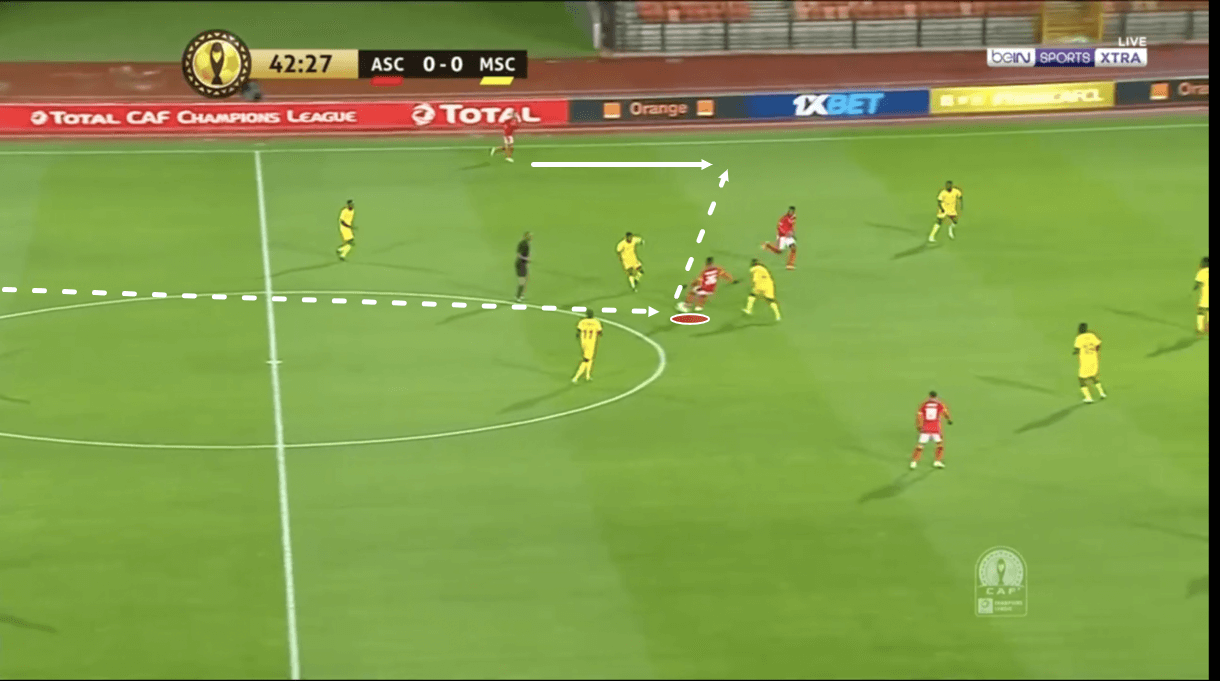
Figure 13 shows a similar example of one of Al Ahly’s attackers dropping deep to collect a pass from the holding midfielder before playing a through ball out to the overlapping left-back.
Al Ahly’s crosses are very evenly spread between the left wing and right wing.
They have played 81 crosses from the left wing this term and 86 crosses from the right wing this term, so the threat is very evenly spread across the pitch.
As the attacker collects the ball in between the lines here, he attracts pressure from several opposition players, which creates more space elsewhere, as we can see, with the left-back taking advantage of that space.
As the play progresses, the left-back carries the ball upfield and sends a dangerous cross into the penalty area.
So, it’s clear that Mosimane’s side has some very effective ways of progressing into the final third and beyond.
They create good goalscoring chances thanks to their high-quality through balls and crosses, which result from their positioning, movement, and passing quality.
Al Ahly’s pressing under Mosimane
Lastly, we’ll take a closer look at Al Ahly’s defensive tactics under Mosimane.
The Red Devils have impressively got the best defensive record of any team in Egypt’s top flight this season, having conceded just four goals in their first nine games of the league season.
In addition, Al Ahly has conceded just 5.32 shots per 90 minutes in the league, which is lower than any other Egyptian Premier League team.
This indicates that they have been effective at shutting their opponents out and protecting their goal.
As we explained earlier on in this tactical analysis piece and as the first image that we analysed in this piece suggested, Mosimane likes his side to defend aggressively, in a high block, winning the ball high up the pitch and giving the opposition little chance to play out from the back.
As a result, Al Ahly tends to press quite aggressively.
They had the sixth-lowest PPDA (8.17) of any Egyptian Premier League side for the 2020/21 campaign, which is lower than the league average of 9.32.
So, while they’re not the most aggressive pressing side in the league, they do press relatively high.
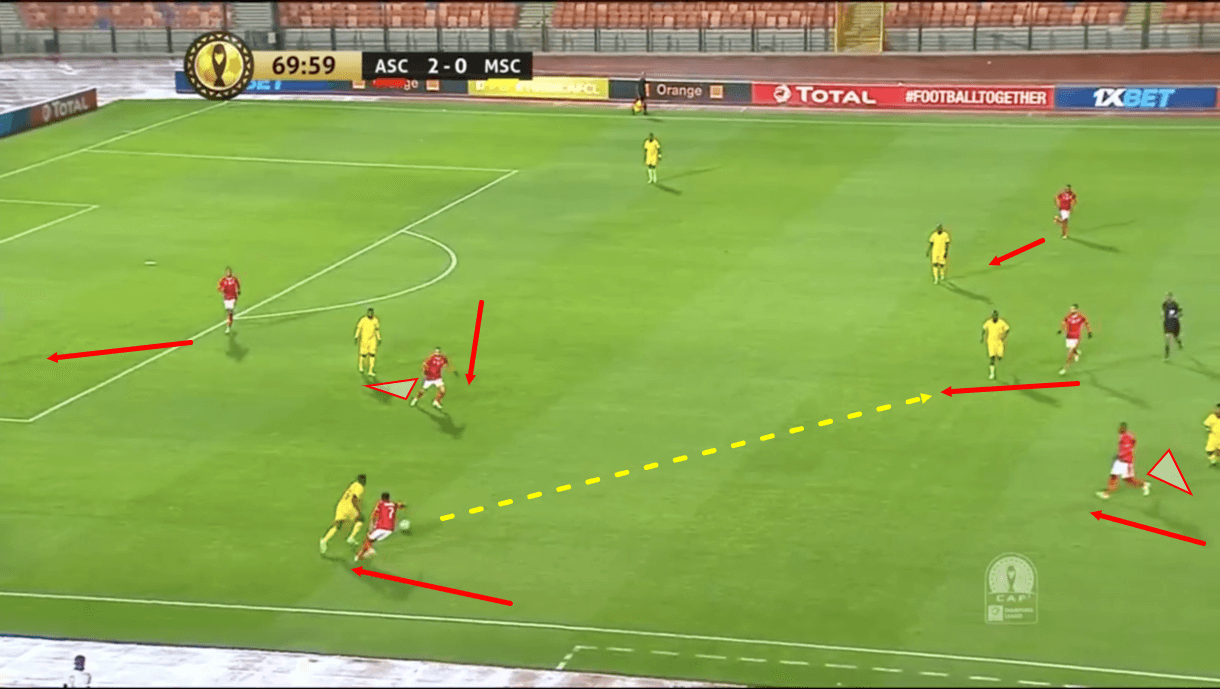
Figure 14 shows us a typical example of Al Ahly’s press in action.
They like to direct the play first towards the wing, forcing the opposition to play to the full-back.
As the ball then makes its way out to the full-back, they attempt to essentially cut the pitch in half, placing one player in position to prevent an easy switch to the other side of the pitch.
The other players focus on covering all near-passing options.
This sees the ball-far winger come quite central, leaving him very far away from the opposition’s ball-far full-back.
This essentially leaves him as an open passing option for the opposition to use to break the press potentially.
Some players will attempt to cut off the passing lane to this player if possible while covering the nearer player that they have picked up, but nobody will generally be marking this player, so that switch from one full-back to the other is one way that teams can often break Al Ahly’s press.
However, if all goes according to plan, the opposition won’t have time to use this passing option.
Al Ahly’s players are quick to get tight to the full-back as he receives the ball, while they’re also quick to get tight to or just cut off the nearest passing options to him.
As a result, provided they don’t play the switch to the opposite full-back, this often either results in the man on the ball being forced long, at which point the Al Ahly centre-backs’ pace/aerial ability are vital to regaining possession or they play a pass into a dangerous area which an Al Ahly player could intercept.
Al Ahly gives up space far away from the ball in favour of packing the space nearer to the ball by picking up the nearest passing options and retaining a compact shape.
Given how successful their defence has been this season, it’s difficult to fault them.
They don’t exactly jump into challenges or really chase down the ball non-stop, but they cut off passing options, and if a good opportunity then presents itself due to a daring or misplaced pass from the opposition player on the ball, then they are reliable at forcing the turnover and they’ve managed to create lots of chances, as well as put a stop to opposition build-up play thanks to their high pressing of late, making this another dangerous tool for them in the attack, as well as defence.
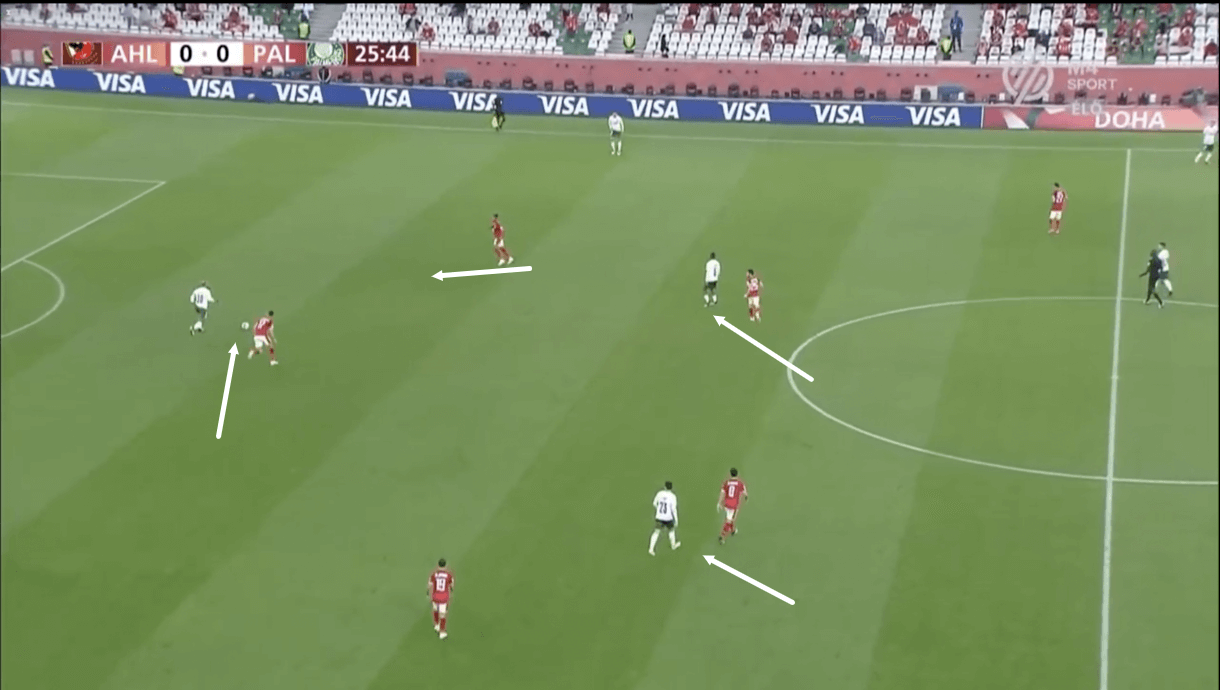
Figure 15 shows us an example of Al Ahly pressing a man on the ball in a more central position.
He is put under pressure from both sides here, with one player threatening to challenge him should he look to turn out and another likely to intercept his pass should he play the ball out towards the full-back in front of him.
His nearest central passing options are also being marked tightly.
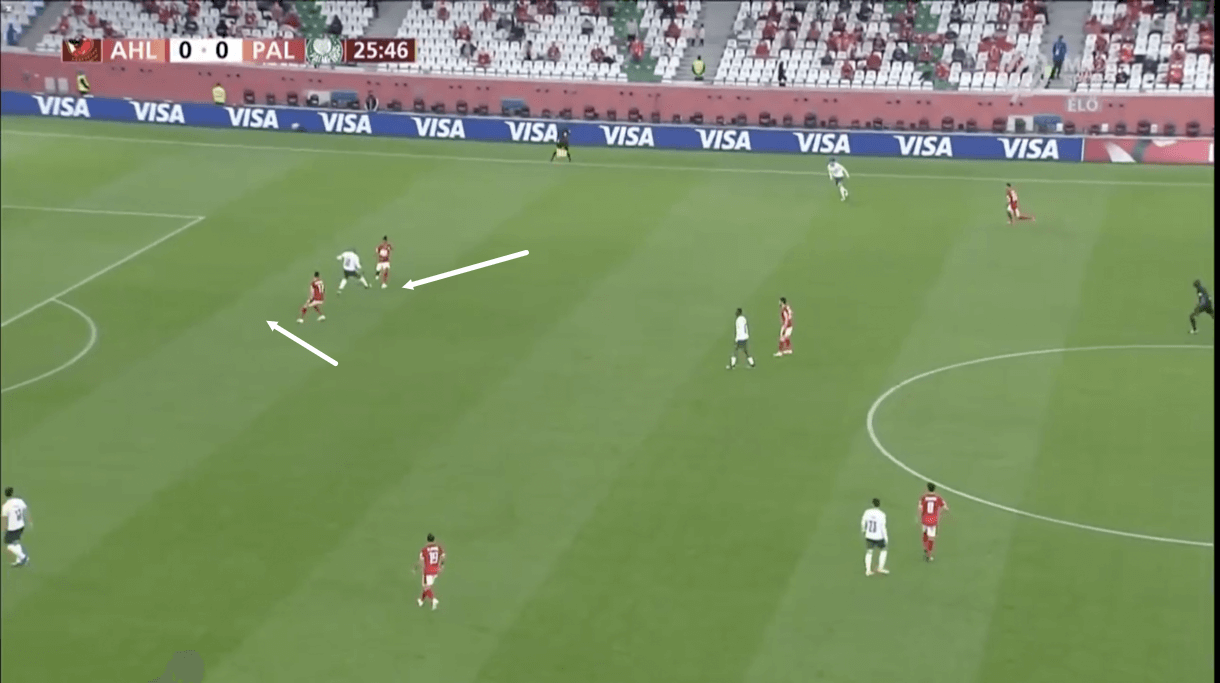
As the play progresses, Figure 16 shows that this ball carrier took too much time on the ball end and ended up getting dispossessed in a difficult position, leading to an Al Ahly counterattack from the very top of the pitch.
In this image, we can also see that the full-back nearest to the opposition full-back in front of the man being dispossessed was also charging him down and closing the space just in case the pass did end up making its way out to him.
The full-backs and midfielders engage in the most defensive duels of anyone in Mosimane’s side, which mightn’t come as a big surprise when you consider that these players are so active in getting tight to opposition players in important areas, as we see here.
They are always on call to cut out potentially dangerous passes in the build-up and later stages of an attack, making them the most active defenders on this side.
However, the attackers are quite active as well.
The centre-backs engage in relatively few defensive duels but perform an important role in dealing with long balls if they result from pressure higher up the pitch.
Conclusion
To conclude this tactical analysis piece, it’s clear that accurate yet progressive passing at a high volume is absolutely key to Mosimane’s tactics, and the elements of technical passing quality, positioning, and movement are important, as they are evident in several aspects of Al Ahly’s offensive game.
Defensively, Al Ahly’s focus is on forcing the opposition to make a mistake and being ready to pounce when they do that, rather than hounding the ball away from them, and this has been successful for them under Mosimane thus far.
The Egyptian side is not without its weaknesses, both on and off the ball, but it has been playing some impressive and successful football under Mosimane thus far, which certainly signifies that the future could be bright for the reigning CAF Champions League champions under the highly regarded South African coach.




Comments